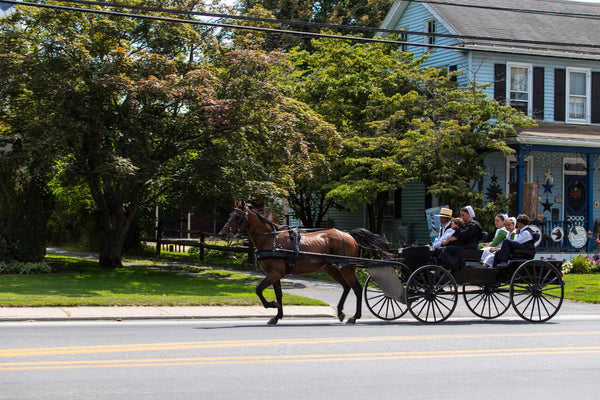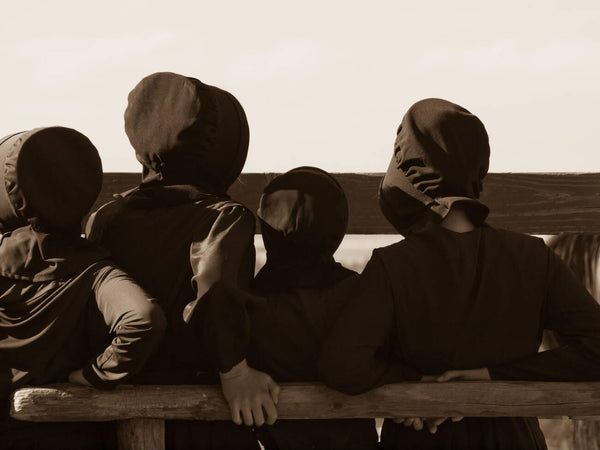The word ‘ritual’ is often bandied about without much care for its meaning and significance. Yet, every social and cultural group since the dawn of time has had its share of traditions and rituals. With this examination of Amish rituals, we take a closer look at what their rituals are, and how they developed.
More importantly, we also discuss what the existence of these rituals has done for the Amish people. Did their rituals lead to their establishment as a separate people? Or did their rituals evolve as a result of their separation? Keep reading and you’ll find out.
What this article covers:
- What Do We Mean By Amish ‘Rituals’?
- Amish Religious Rituals
- Amish Societal Rituals
- Amish Courtship Rituals
- Wedding Rituals
- Amish Funeral Rituals
- Amish Punishment Rituals
What Do We Mean By Amish ‘Rituals’?

Rituals are repetitive patterns that symbolize culturally held beliefs. They align the belief system of the individual with that of their cultural group, thereby enhancing social cohesion.
In time, these rituals become second nature to the participant. He or she will continue to partake in them and teach them to the next generation, often without questioning their history or purpose.
Most people immediately think of religion when they hear the word rituals, and they certainly are a big part of any religious observance, but they can take different forms, in different situations.
How Are Rituals Different from Traditions?
Traditions are also behaviors handed down from one generation to the next. However, rituals are the consistent series of acts that accompany and solidify a culture’s traditional behaviors and customs.
Without the actions of rituals, the belief behind the traditions will ultimately not survive. Let’s take a look now at some of these rituals that have kept the various traditions, customs, and Amish laws alive.
Amish Religious Rituals
The Amish culture has been developed around their religious beliefs. It’s their religious rituals that set them apart from the very beginning, which caused them to break away from their Anabaptist origins.
Their history can be traced back to centuries before the Amish settled in America, fleeing religious persecution in their native Europe.
Church Attendance

While the Amish are a very religious community, not every Amish Sunday is spent in church service. Every second Sunday, the Community congregates to attend a church service. Their Bible is read as a Lutheran version in Old High German.
Hymns are also sung, chosen from an old hymnal that is precious to the Amish culture, called the ‘Ausbund’ This is the oldest Christian songbook still in use anywhere. A sermon may be given by one of the Elders, and prayers will be said. This can all take up to 3 or more hours.
The alternate Sundays are days of rest and community fellowship. They’re not intended for work, but as a time for the Amish community to take part in other customs and traditions that they hold dear.
The Amish do, contrary to popular belief, enjoy leisure activities. Board games, and sports like softball or volleyball, are popular. Nothing that goes against their principles of pacifism, modesty, and separation from modern life is allowed.
Baptism
Unlike some other Christian denominations, the Amish believe in and insist on adult baptism. The notion of infant baptism is rejected, as infants and children cannot make decisions of such spiritual importance. Only professing Christians, who understand the significance of their decision, should be baptized.
The Amish are far from alone in practicing the ritual of adult baptism. As descendants of the Swiss Anabaptists, the Amish have retained many of the Anabaptist Protestant beliefs and rituals. One of these is the ritual of adult baptism. This ritual is also practiced by other Baptist congregations.
When an Amish person is in their late teens they may decide to get baptized. This doesn’t only mean that they’re professing their religious faith. It’s also their entrance into the Amish way of life. Amish people may only marry others who have been baptized into the Amish community.

Communion
The founder of the Amish community, Jakob Amman, was a Swiss Anabaptist. He and some of his followers held alternative views to the church’s elders. These centered around being re-baptized into a new and separate way of life, the ex-communication of sinners, and the practice of foot washing.
In time, other points of disagreement arose such as Amman and his followers’ desire for more frequent communion services. To avoid conflict, and escape persecution, they emigrated to America. Here they could live their lives as a separate community, practicing these rituals that they deeply believed in.
Communion services are high points in Amish religious life, and these rituals take place during fall and spring each year. Before the communion service, Amish church members confess their sins and renew their vows to uphold the laws set out in the ‘Ordnung’ (their Amish rule book).
Footwashing
The ritual of foot-washing put the forefathers of today’s Amish community at odds with the church leadership of the Anabaptist sect. This is still practiced by the Amish today, at the end of communion services. The purpose is to encourage humility and harmony among community members.
They take as their inspiration the example of Jesus Christ, who famously washed his disciples’ feet. The Amish believe in Jesus, and acknowledge him as the Son of God. They also see him as a role model of good behavior.
They believe that Christ meant for others to follow his example, as evidenced by the Bible verse in John 13: 1-17. Footwashing was also mentioned in the Old Testament, as a ritual of hospitality. As the Amish are very devoted to their faith, they take this scriptural passage very seriously.
Amish Societal Rituals
The community is of great importance in Amish culture, hence many Amish rituals revolve around community life.
These rituals were born in Europe centuries ago and developed around the settlements that sprung up on arrival in America.
Barns, Baskets and Beyond
Many Amish traditions have been passed down to each successive generation since they first settled here. The most identifiable of these are their trades and crafts.
However, unlike modern western society, they haven’t let these customs be tainted by technological progress. Instead, they hold fast to their timeless methods with ritualistic devotion. Primarily farmers, the Amish work the land and raise barns for livestock and storage with their handiwork.
Modern tools and equipment are forbidden, which means that young men today practice their craft with the same methods and the same steps as their forefathersThis can also be seen in the basket weaving tradition that the Amish engage in.
Amish hand-woven pie baskets and storage stair baskets are a staple in Amish homes, but they’re also sold to earn an income for the community, along with other wicker basket products. Examples include their charming toilet paper baskets and practical wall-hanging mail organizers.
Amish Courtship Rituals
Like every other culture, the Amish have unique courtship rituals, too. Dating is allowed, but it doesn’t follow the norms of contemporary western society.
One of the Amish bedroom rituals that are hard for outsiders to understand, is the ritual of ‘bundling’.
Bundling
One that’s very misunderstood by non-Amish who hear of it, is ‘bundling’. While this courtship ritual may seem unique to the Amish, it’s based on old European courtship rituals pre-dating the development of Amish culture.
Bundling appears to have originated in Western Europe in the 16th century, although some believe that it has its roots in ancient Jewish customs. Whatever the case, the concept remains the same. Two young people who are dating, spend the night in bed together.
We can hear what you’re thinking. Do Amish sleep together before marriage? It’s nowhere near as risque as it sounds. Pre-marital sex is forbidden by Amish law. They’re fully clothed and have an obstacle placed between them.
Bundling is a way for the young couple to foster closeness while resisting temptation. The more progressive Amish communities no longer practice this ritual, but many conservative ones still do.
Wedding Rituals

Every society has its wedding traditions and rituals, and the Amish are no different. Most of their wedding rituals mirror those of many other European cultures. This isn’t unusual, as the Amish are descended from European settlers.
There’s a wedding ceremony, and the community gathers afterward to celebrate with delicious home-baked foods and treats. However, there are two big differences. There’s no honeymoon trip, and there’s no fancy wedding dress.
‘Honeymoon’ in the Bride’s Parents’ Home
The wedding night, and probably the first few months of marriage, is spent living in the bride’s parents’ home. The morning after the wedding, the couple will rise early, and help with the post-wedding clean-up. They’ll live with the bride’s family until they are ready to live in their own home,
During their time there, a new house will be constructed for the young couple by the members of the community. All houses, barns, and community spaces are built by the Amish themselves. They’re master carpenters, using traditional methods passed down by generations of fathers to their sons.
Homemade Wedding Dress
There are several Amish women’s rules. Most of these are related to the need for modesty and submission to the husband as head of the household. Amish women are the caregivers of the community, while men are the breadwinners. It is a very patriarchal system and exists in all Amish settlements.

Marriage takes place early in life for most Amish. As soon as a community member is baptized in their late teens or early twenties, they may get married and start a family. Marriage to an outsider is forbidden unless they renounce their modern ways and are baptized into the Amish faith.
The concept of the wedding ceremony, with a feast of delicious foods afterward, is common in western culture. But one Amish wedding ritual is not. The bride must wear a long homemade dress, similar to the modest attire she is expected to wear at all times. No embellishments or adornments are allowed.
Most married couples will go on to have large families. This isn’t difficult to understand, as they marry young and don’t use modern contraceptive methods, but there’s another reason for it. Children are seen as a blessing, and therefore it isn’t a rarity to see Amish families with more than half a dozen children.
Wedding Dress Becomes Church Attire
The bride will wear that wedding dress to every church service for the rest of her life. In modern society, wedding dresses are never worn again, no matter the expense incurred. One could say that without realizing it, this Amish wedding ritual is a good example of sustainable living.
All aspects of Amish life are examples of sustainable living. They don’t believe in the trappings of excess, displays of wealth, or unnecessary attachment to material things. This is one of the main reasons why they live such simple lives. A lot of emphasis is placed on humility in the Amish community.
Amish Funeral Rituals

Due to its ties to beliefs about life, death, and the afterlife, Amish funerals have many associated rituals. While certain Amish funeral rituals align with old European customs, there are significant differences too. These differences can be ascribed to their religious beliefs.
The Preparation of the Body
The body of a deceased is prepared in much the same way that it would be in other cultures. However, this preparation is done by community members. Because the body isn’t held in a morgue, the arrangements for a funeral and burial take place within 3 days.
Of course, it’s usually necessary for a body to be embalmed. As the Amish are unable to do this by themselves, they usually have a mortician in a local town who assists. They may fetch the body, perform the essential embalming service, and then return it.
Family members of the deceased make a new set of clothes for the deceased person to wear. However, an Amish woman will, if she was married, be buried in her wedding dress. (there’s that much-loved wedding dress, again.)
The Funeral

The funeral will consist of a viewing of the body, and a funeral service, as with many other cultures. The pallbearers, however, must match the deceased in their marital status. They aren’t only tasked with carrying the coffin to the grave.
They’re also responsible for the viewing, and transportation to the graveside. This will be done with a horse and buggy, as the Amish are forbidden to own and operate motor vehicles, The traditional horse and buggy perform the role of the hearse.
The Burial
It’s the burial ritual that’s the most different to western contemporary funerals. The coffin is made of the community, plain wood. No embellishment is allowed, not even an interior lining or handles, The coffin is lowered into a freshly dug grave and then it’s covered by soil, but no elaborate headstone is allowed.
There are no statuettes, no flowers, and no wreaths. A simple stone with only essential information, which includes the deceased’s name, birth, and death dates, is permitted. In some ultra-conservative Old Order communities, an even simpler wooden grave marker with only the deceased’s initials may be used.
After the Funeral
For up to a year after the funeral and burial, community members will visit the family of the deceased on a Sunday. This mark of respect helps them to bear their grief, with the support of the community. The Amish don’t view death as the end though. It’s seen as a necessary part of life, and the beginning of the next important phase of being.

Death is seen as the gateway to heaven when the departed return to be with God. The Amish do mourn their dead, and families who lose a loved one wear black for a time after to signify their loss. The remaining community members are inspired to live better lives, preparing for when they too depart this world.
Amish Punishment Rituals
While it’s very rarely practiced, Amish shunning rules are often all that non-Amish know about the Amish culture. This punishment ritual is often misunderstood. The act of shunning is reserved for individuals who have transgressed the laws in the Ordnung, or engaged in otherwise inappropriate behavior.
No one will be shunned without cause, and they’re usually warned to repent of their sinful ways. Failure to do so can result in shunning. This means that they won’t be acknowledged by the community until they repent.
Should the wrongdoer persist in their transgressions, the final step of ex-communication may be taken. This happens only in the most extreme of cases. The ritual of shunning, while a punishment, is also seen as an opportunity to teach the individual the consequences of their actions and the need to repent.

Conclusion
While traditions can continue for millennia, virtually unchanged, they rely on the rituals associated with them, to survive.
Amish beliefs, traditions, and rituals all have one end goal – their continuation as a people, devoted to God’s will. Amish rituals are a fascinating example of a culture built on a foundation of piety and faith.
Did You Find Our Blog Helpful? Then Consider Checking:
- Amish Values
- Amish Symbol
- Amish Marriage Rules
- Amish Dating Rules
- Do Amish Believe in Jesus
- What Bible Do the Amish Use
- Amish Baptism Ritual
- What Day Do the Amish Go to Church
- Amish Religion
- What Do the Amish Believe Happens After Death
- Amish Traditions
- Is Amish a Cult
- Amish Law
- Amish Punishments
- Old Order Amish Beliefs


